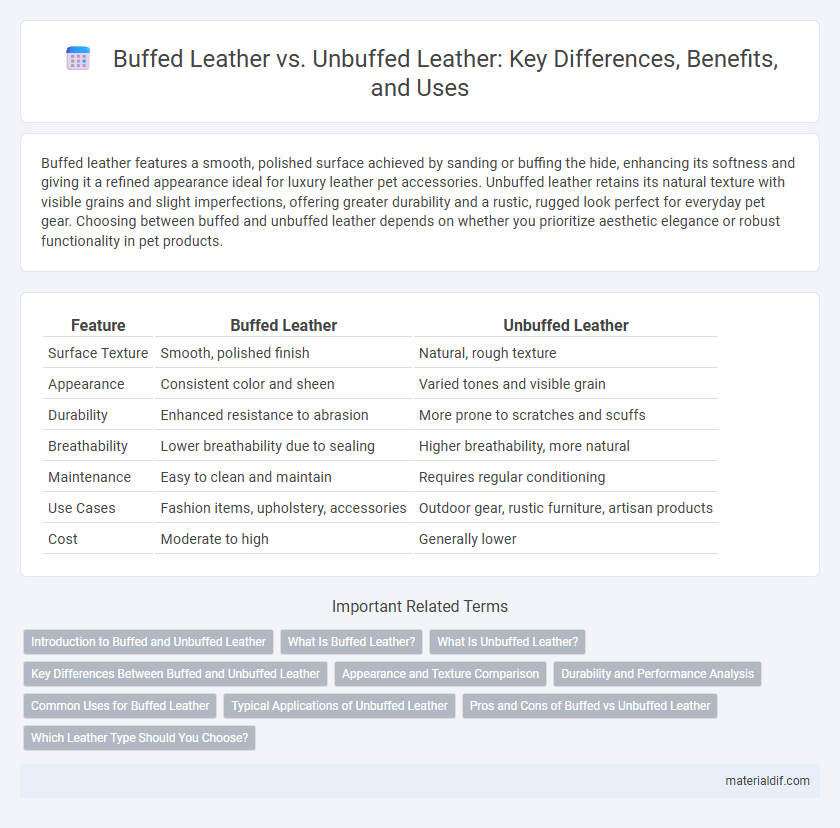Buffed leather features a smooth, polished surface achieved by sanding or buffing the hide, enhancing its softness and giving it a refined appearance ideal for luxury leather pet accessories. Unbuffed leather retains its natural texture with visible grains and slight imperfections, offering greater durability and a rustic, rugged look perfect for everyday pet gear. Choosing between buffed and unbuffed leather depends on whether you prioritize aesthetic elegance or robust functionality in pet products.
Table of Comparison
| Feature | Buffed Leather | Unbuffed Leather |
|---|---|---|
| Surface Texture | Smooth, polished finish | Natural, rough texture |
| Appearance | Consistent color and sheen | Varied tones and visible grain |
| Durability | Enhanced resistance to abrasion | More prone to scratches and scuffs |
| Breathability | Lower breathability due to sealing | Higher breathability, more natural |
| Maintenance | Easy to clean and maintain | Requires regular conditioning |
| Use Cases | Fashion items, upholstery, accessories | Outdoor gear, rustic furniture, artisan products |
| Cost | Moderate to high | Generally lower |
Introduction to Buffed and Unbuffed Leather
Buffed leather features a smooth, polished surface achieved through sanding or buffing, enhancing its softness and aesthetic appeal, ideal for high-end fashion and upholstery. Unbuffed leather retains its natural grain and texture, offering greater durability and a rugged, authentic appearance preferred for workwear and rustic accessories. Understanding the distinct processing methods of buffed and unbuffed leather helps in selecting the right material for specific uses based on texture, durability, and finish.
What Is Buffed Leather?
Buffed leather is leather that has undergone a surface treatment where the top grain is lightly abraded to remove imperfections, creating a smooth, uniform finish. This process enhances the leather's texture and prepares it for dyeing or finishing, improving its aesthetic appeal and durability. In contrast, unbuffed leather retains its natural surface with visible grain inconsistencies, offering a more rugged and authentic look.
What Is Unbuffed Leather?
Unbuffed leather refers to hides that retain their natural grain and surface imperfections without undergoing the buffing process, which smooths and abrades the surface to create a uniform texture. This type of leather exhibits a more rugged, authentic appearance with visible pores, scars, and natural marks, enhancing its character and uniqueness. Unbuffed leather typically maintains greater durability and breathability compared to buffed leather, making it ideal for products requiring a natural, resilient finish.
Key Differences Between Buffed and Unbuffed Leather
Buffed leather undergoes a mechanical polishing process that smooths its surface, enhancing softness and creating a uniform appearance, while unbuffed leather retains its natural grain and texture, offering greater durability and a more rugged look. Buffed leather typically has a lighter shade and a more refined finish due to surface abrasion, whereas unbuffed leather preserves its original color variations and natural imperfections. The key differences lie in tactile feel, aesthetic qualities, and maintenance, with buffed leather requiring more care to prevent scratches and unbuffed leather providing better resistance to wear and tear.
Appearance and Texture Comparison
Buffed leather features a smooth, matte finish achieved by sanding the surface, resulting in a uniform texture with minimal imperfections, ideal for refined and polished appearances. Unbuffed leather retains its natural grain and surface irregularities, offering a more rugged, authentic look with a slightly coarse texture that highlights the leather's original character. The visual contrast between buffed and unbuffed leather is distinct, with buffed leather presenting a sleek, modern aesthetic, while unbuffed leather provides a rustic, organic feel favored in traditional and vintage designs.
Durability and Performance Analysis
Buffed leather exhibits enhanced durability due to its polished surface, which increases resistance to wear and tear compared to unbuffed leather. The buffing process smooths out imperfections, leading to improved tensile strength and better performance under frequent use. Unbuffed leather, while more porous, offers a natural texture but is prone to faster abrasion and reduced lifespan in high-stress applications.
Common Uses for Buffed Leather
Buffed leather is commonly used in products requiring a smooth, refined finish such as high-end footwear, luxury handbags, and upholstery. This type of leather undergoes a buffing process that removes imperfections and enhances suppleness, making it ideal for visually appealing and durable goods. Its polished surface also makes buffed leather popular in fashion accessories and automotive interiors where aesthetic appeal is paramount.
Typical Applications of Unbuffed Leather
Unbuffed leather is commonly used in heavy-duty applications such as work boots, belts, and industrial gloves due to its natural texture and superior durability. Its rough surface provides better grip and resistance to wear, making it ideal for rugged environments and outdoor gear. This type of leather is preferred for products requiring strength and longevity rather than a polished finish.
Pros and Cons of Buffed vs Unbuffed Leather
Buffed leather offers a smoother, polished finish that enhances durability and stain resistance, making it ideal for high-wear applications; however, it may lose some natural texture and breathability compared to unbuffed leather. Unbuffed leather retains its raw, rugged surface, providing a unique, authentic look and improved moisture absorption but can be more susceptible to scratches, stains, and wear over time. Choosing between buffed and unbuffed leather depends on whether durability and ease of maintenance or natural aesthetics and breathability are prioritized.
Which Leather Type Should You Choose?
Buffed leather offers a smooth, polished surface that enhances durability and resistance to stains, making it ideal for high-use items like furniture and footwear. Unbuffed leather retains a natural, textured appearance with more visible grain, preferred for those seeking a rustic or vintage look with softer, more breathable characteristics. Choose buffed leather for a sleek, easy-to-clean finish, while unbuffed leather suits projects where natural aesthetics and comfort are prioritized.
Buffed leather vs Unbuffed leather Infographic

 materialdif.com
materialdif.com